八年级下册 Unit 3-4(讲练学案)-2023年中考英语第一轮复习讲练测(沪教牛津版)
文档属性
| 名称 | 八年级下册 Unit 3-4(讲练学案)-2023年中考英语第一轮复习讲练测(沪教牛津版) | 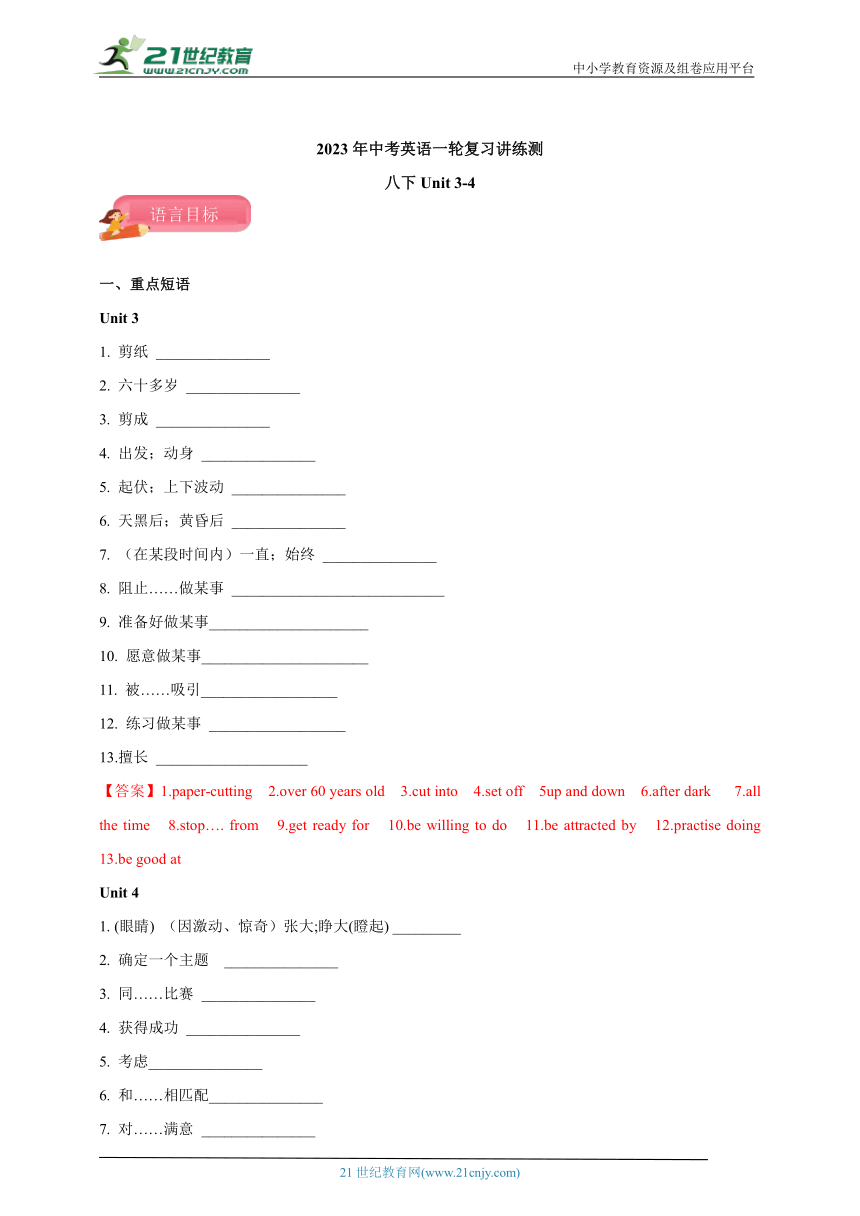 | |
| 格式 | docx | ||
| 文件大小 | 1002.5KB | ||
| 资源类型 | 试卷 | ||
| 版本资源 | 牛津深圳版 | ||
| 科目 | 英语 | ||
| 更新时间 | 2023-02-23 21:10:14 | ||
图片预览

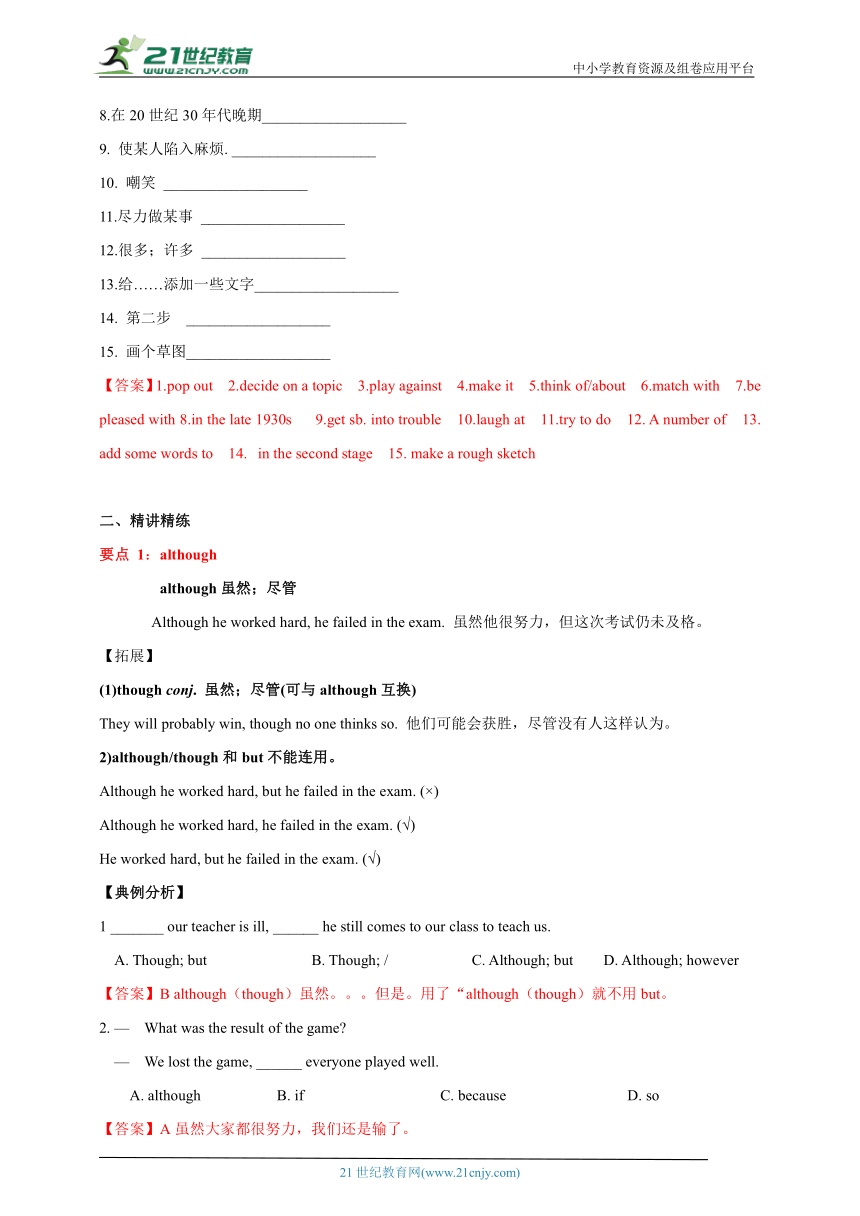
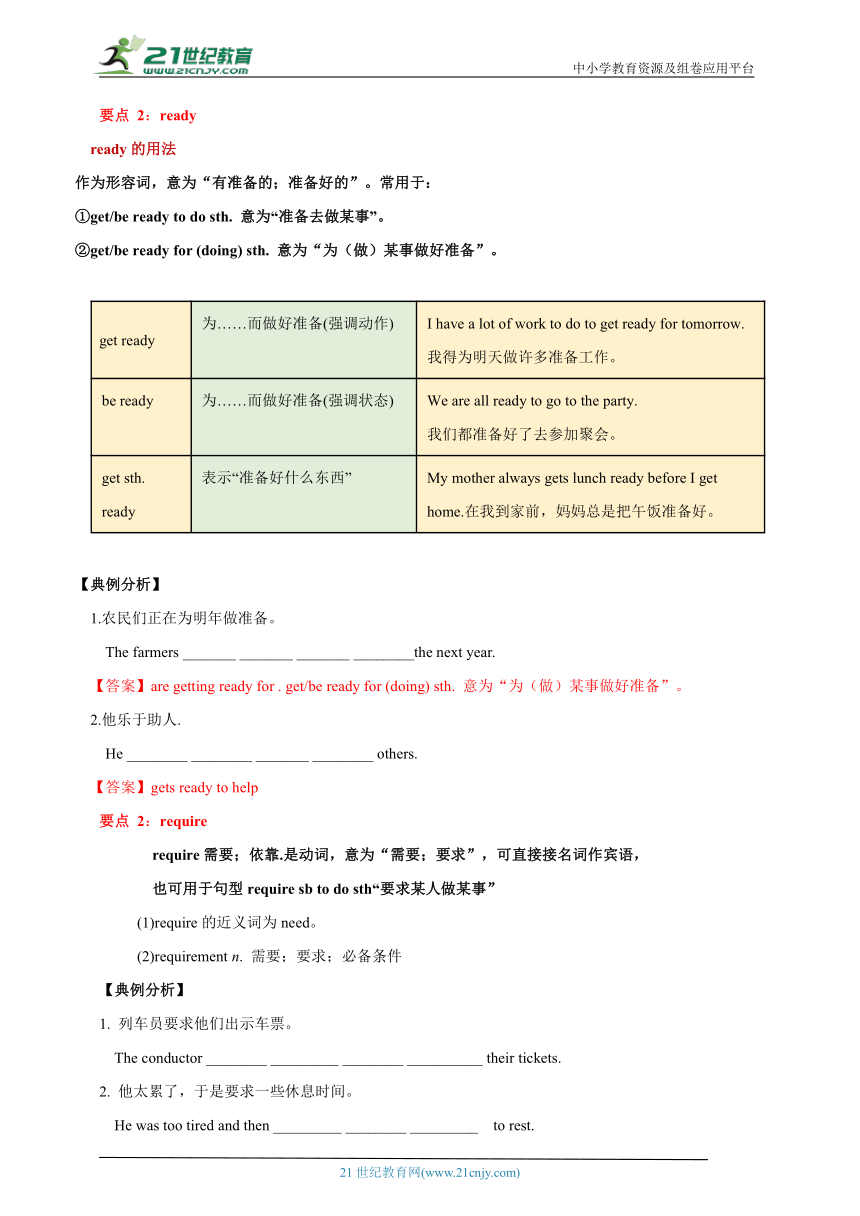
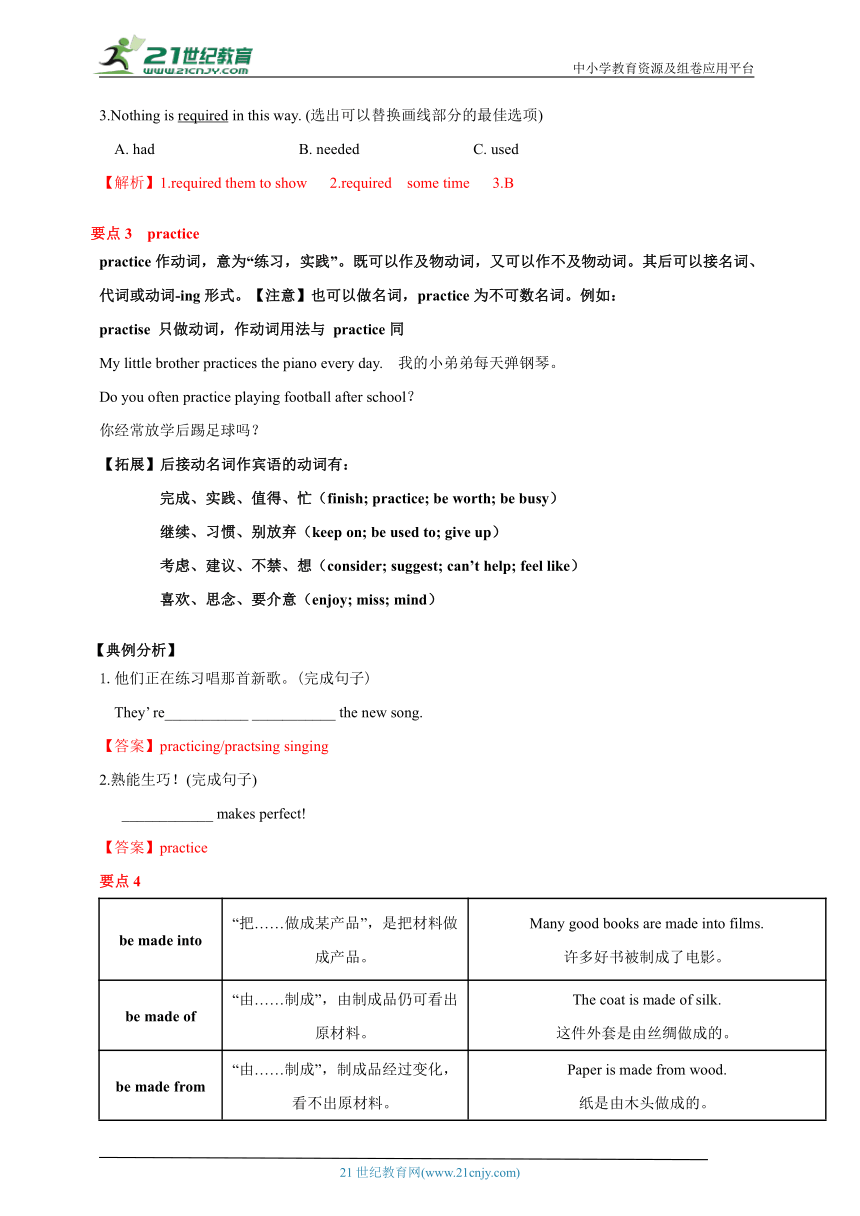
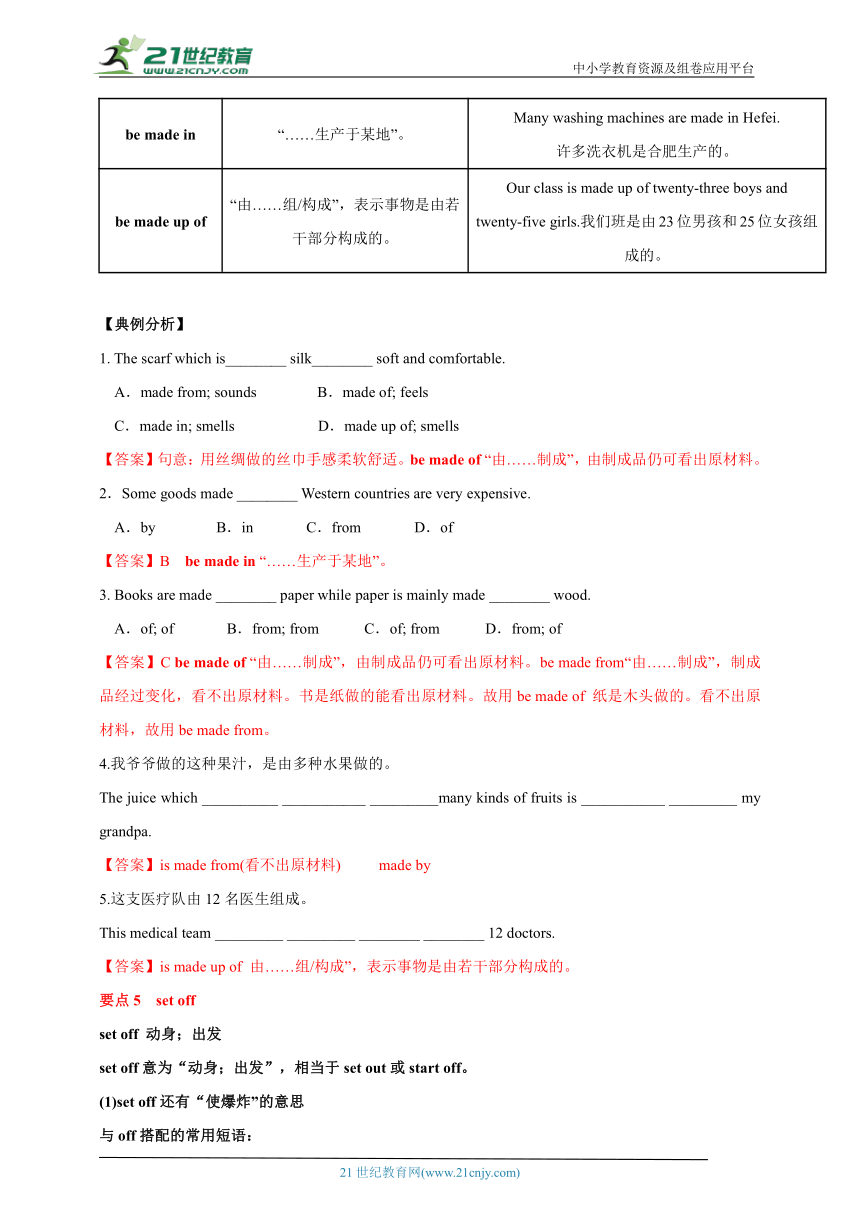
文档简介
中小学教育资源及组卷应用平台
2023年中考英语一轮复习讲练测
八下Unit 3-4
一、重点短语
Unit 3
1. 剪纸 _______________
2. 六十多岁 _______________
3. 剪成 _______________
4. 出发;动身 _______________
5. 起伏;上下波动 _______________
6. 天黑后;黄昏后 _______________
7. (在某段时间内)一直;始终 _______________
8. 阻止……做某事 ____________________________
9. 准备好做某事_____________________
10. 愿意做某事______________________
11. 被……吸引__________________
12. 练习做某事 __________________
13.擅长 ____________________
【答案】1.paper-cutting 2.over 60 years old 3.cut into 4.set off 5up and down 6.after dark 7.all the time 8.stop…. from 9.get ready for 10.be willing to do 11.be attracted by 12.practise doing 13.be good at
Unit 4
1. (眼睛) (因激动、惊奇)张大;睁大(瞪起) _________
2. 确定一个主题 _______________
3. 同……比赛 _______________
4. 获得成功 _______________
5. 考虑_______________
6. 和……相匹配_______________
7. 对……满意 _______________
8.在20世纪30年代晚期___________________
9. 使某人陷入麻烦. ___________________
10. 嘲笑 ___________________
11.尽力做某事 ___________________
12.很多;许多 ___________________
13.给……添加一些文字___________________
14. 第二步 ___________________
15. 画个草图___________________
【答案】1.pop out 2.decide on a topic 3.play against 4.make it 5.think of/about 6.match with 7.be pleased with 8.in the late 1930s 9.get sb. into trouble 10.laugh at 11.try to do 12. A number of 13. add some words to 14. in the second stage 15. make a rough sketch
二、精讲精练
要点 1:although
although虽然;尽管
Although he worked hard, he failed in the exam. 虽然他很努力,但这次考试仍未及格。
【拓展】
(1)though conj. 虽然;尽管(可与although互换)
They will probably win, though no one thinks so. 他们可能会获胜,尽管没有人这样认为。
2)although/though和but不能连用。
Although he worked hard, but he failed in the exam. (×)
Although he worked hard, he failed in the exam. (√)
He worked hard, but he failed in the exam. (√)
【典例分析】
1 _______ our teacher is ill, ______ he still comes to our class to teach us.
A. Though; but B. Though; / C. Although; but D. Although; however
【答案】B although(though)虽然。。。但是。用了“although(though)就不用but。
2. — What was the result of the game
— We lost the game, ______ everyone played well.
A. although B. if C. because D. so
【答案】A虽然大家都很努力,我们还是输了。
要点 2:ready
ready的用法
作为形容词,意为“有准备的;准备好的”。常用于:
①get/be ready to do sth. 意为“准备去做某事”。
②get/be ready for (doing) sth. 意为“为(做)某事做好准备”。
get ready 为……而做好准备(强调动作) I have a lot of work to do to get ready for tomorrow. 我得为明天做许多准备工作。
be ready 为……而做好准备(强调状态) We are all ready to go to the party. 我们都准备好了去参加聚会。
get sth. ready 表示“准备好什么东西” My mother always gets lunch ready before I get home.在我到家前,妈妈总是把午饭准备好。
【典例分析】
1.农民们正在为明年做准备。
The farmers _______ _______ _______ ________the next year.
【答案】are getting ready for . get/be ready for (doing) sth. 意为“为(做)某事做好准备”。
2.他乐于助人.
He ________ ________ _______ ________ others.
【答案】gets ready to help
要点 2:require
require需要;依靠.是动词,意为“需要;要求”,可直接接名词作宾语,
也可用于句型require sb to do sth“要求某人做某事”
(1)require的近义词为need。
(2)requirement n. 需要;要求;必备条件
【典例分析】
1. 列车员要求他们出示车票。
The conductor ________ _________ ________ __________ their tickets.
2. 他太累了,于是要求一些休息时间。
He was too tired and then _________ ________ _________ to rest.
3.Nothing is required in this way. (选出可以替换画线部分的最佳选项)
A. had B. needed C. used
【解析】1.required them to show 2.required some time 3.B
要点3 practice
practice作动词,意为“练习,实践”。既可以作及物动词,又可以作不及物动词。其后可以接名词、代词或动词-ing形式。【注意】也可以做名词,practice为不可数名词。例如:
practise 只做动词,作动词用法与 practice同
My little brother practices the piano every day. 我的小弟弟每天弹钢琴。
Do you often practice playing football after school?
你经常放学后踢足球吗?
【拓展】后接动名词作宾语的动词有:
完成、实践、值得、忙(finish; practice; be worth; be busy)
继续、习惯、别放弃(keep on; be used to; give up)
考虑、建议、不禁、想(consider; suggest; can’t help; feel like)
喜欢、思念、要介意(enjoy; miss; mind)
【典例分析】
1.他们正在练习唱那首新歌。(完成句子)
They’ re___________ ___________ the new song.
【答案】practicing/practsing singing
2.熟能生巧!(完成句子)
____________ makes perfect!
【答案】practice
要点4
be made into “把……做成某产品”,是把材料做成产品。 Many good books are made into films. 许多好书被制成了电影。
be made of “由……制成”,由制成品仍可看出原材料。 The coat is made of silk. 这件外套是由丝绸做成的。
be made from “由……制成”,制成品经过变化,看不出原材料。 Paper is made from wood. 纸是由木头做成的。
be made in “……生产于某地”。 Many washing machines are made in Hefei. 许多洗衣机是合肥生产的。
be made up of “由……组/构成”,表示事物是由若干部分构成的。 Our class is made up of twenty-three boys and twenty-five girls.我们班是由23位男孩和25位女孩组成的。
【典例分析】
1. The scarf which is________ silk________ soft and comfortable.
A.made from; sounds B.made of; feels
C.made in; smells D.made up of; smells
【答案】句意:用丝绸做的丝巾手感柔软舒适。be made of “由……制成”,由制成品仍可看出原材料。
2.Some goods made ________ Western countries are very expensive.
A.by B.in C.from D.of
【答案】B be made in “……生产于某地”。
3. Books are made ________ paper while paper is mainly made ________ wood.
A.of; of B.from; from C.of; from D.from; of
【答案】C be made of “由……制成”,由制成品仍可看出原材料。be made from“由……制成”,制成品经过变化,看不出原材料。书是纸做的能看出原材料。故用be made of 纸是木头做的。看不出原材料,故用be made from。
4.我爷爷做的这种果汁,是由多种水果做的。
The juice which __________ ___________ _________many kinds of fruits is ___________ _________ my grandpa.
【答案】is made from(看不出原材料) made by
5.这支医疗队由12名医生组成。
This medical team _________ _________ ________ ________ 12 doctors.
【答案】is made up of 由……组/构成”,表示事物是由若干部分构成的。
要点5 set off
set off 动身;出发
set off意为“动身;出发”,相当于set out或start off。
(1)set off还有“使爆炸”的意思
与off搭配的常用短语:
get off 下车 take off 脱下,起飞
run off 跑开 see off 送行
cut off 切开 turn off 关掉
put off 推迟 go off 离开,走掉,走散
keep off 远离,不接近 fall off 掉落
【典例分析】
1.We have to ______ our sports meeting till next week because of the heavy rain.
A. take off B. get off C put off D. set off
【答案】C
【解析】句意:因为下大雨,我们不得不把运动会推迟到下周。take off脱下,起飞 get off下车 put off 推迟 set off出发,动身。根据句意选C
要点6
hang v. 悬挂;吊
Several dresses are hanging in the cupboard.橱柜里挂着几套礼服。
1)hang的用法小结:
词条 词义 过去式/过去分词
hang 悬挂;吊 hung/hung
绞死 hanged/hanged
2)hang up挂断电话 hang out闲逛
Don't hang up. I'll get a pen and a notebook.
别挂断电话,我找支钢笔和笔记本。
Mrs. Read was hanging out with her friend when she heard that a terrorist was hanged yesterday.
昨天里德夫人正在和朋友逛街时听说一名恐怖分子被处以绞刑了。
【典例分析】
1.用hang的适当形式填空
(1)The man was ________ as a spy(间谍) in the morning.
(2)Don't ________ your overcoat here, Mike.
(3)A blue coat was ________ on the wall.
(4)Please ________ the wet clothes near a fire.
【答案】(1)ganged (2)hang (3)hung (4)hang
要点7 attract
attract v吸引;使喜爱
Who do you want to attract 你想要吸引谁?
(1)attractive adj. 吸引人的
She’s a very attractive woman. 她是一个非常有吸引力的女人。
2)attraction n. 吸引;吸引人的事物
Do you feel any attraction for this book 你觉得这本书有什么吸引力吗?
(3)be attracted by被……吸引
I’m totally attracted by the story. 我完全被这个故事吸引了。
【典例分析】
1.The story is very ____________ (attract).
2.He visited many ____________ (attract)in Australia.
3.她试图引起服务员的注意。(根据中文意思完成句子)
She________ _________ _________ the attention of the waiter.
4. The famous place of interest a_______ millions of people to visit every year. (根据首字母写单词完成句子)
【答案】1.atractive (吸引人的,形容词) 2. attractions (名词,吸引;吸引人的事物)
3. tried to attract 4.attracts
要点 8:warning
warning n. 警告;警示
warn v. 警告;提醒;告诫
warn sb. (not) to do sth. 警告某人(不)做某事
warn sb. of/about sth. 警告/通知某人有某事
③warn sb. against doing sth. 警告/告诫某人不要做某事
【典例分析】
1.我们告诫孩子们不要在薄冰上行走。(完成句子)
We________ the children ________ ________ ______on the thin ice.
2.父母警告儿子当心大型动物。(完成句子)
The parents ________ their son __________ the big animals.
3.We ____________ (warning)him not to drive so fast but he didn’t listen.
4.If you don’t keep those ____________ (warn) in mind, you’ll get into danger.
【答案】1.warned not to walk 2.warned of/about 3.warned 4.warnings
要点9:pleasant
pleasant adj. friendly and polite 友好的;和善的;文雅的
作形容词,还可意为 “高兴的,愉快的”,一般指天气、时间、旅行等令人感到高兴、愉快和舒服。
(1) pleased adj. 高兴的;满意的
(2) please v. 请;使高兴
(3) pleasure n. 快乐
【典例分析】
1.She gives me a pleasant smile. (选出可以替换画线部分的最佳选项)
A. friendly B. ugly C. silly
2.He feels ____________ (pleasant)with the work.
3.It is a ____________ (pleasant)to go with you.
【答案】1.A pleasant adj. 友好的;和善的;= friendly 2. pleased高兴的;满意的 be pleased with
对。。。满意 3.pleasure 名词。快乐。
要点 10 thought
thought n. 心思;思想
(1) think v. 想;思考
(2) thinker n. 思想家;思想者
(3) thought的同义词为idea。
(4)含有think的短语:
think about / of 思索;考虑; 回顾;想起;想到(某人或某事)
think over 仔细考虑;重新考虑(指想过了, 再想)
think highly of 高度评价;器重
be lost in thought 陷入沉思
【典例分析】
1.Confucius is a great Chinese ____________ (thought).
2.What do you________ the plan It’s wonderful
A. think over B. think twice C. thinks of
3.你敲门的时候我正在沉思。
I ________ _________ _________ ____________ when you knocked on the door.
【答案】1.thinker 思想家 2.C what do you think of…你认为。。。怎么样? 3.was lost in thought 陷入沉思。
要点 11:separately
separately adv. as a separate person or thing; not together 单独地;分别地
(1) separate adj. 单独的;分别的; v. 使分离
(2)separate from 分离
【典例分析】
1.Police moved in to___________ (separately) the two groups.
2.They have their ____________ (separately)room to rest.
3.It’s better for students to do homework separately. (选出可以替换画线部分的最佳选项)
A. together B. not together C. individual
【答案】1.separate 动词。分离。 2. Separate 形容词。单独的;分别的。 3.B
要点 12:
decide on决定;选定
(1)decide to do 决定去做
(2)make a decision to do=make up one’s mind to do决定去做
【典例分析】
1.They decided _____ the plan together.
A. of B. about C. on
2.They decided to go shopping together. (选出可以替换画线部分的最佳选项)
A. made up their mind B. started C. needed
3.最后她决定穿黄色的连衣裙,不穿绿色的。
Finally, she _________ ___________ the yellow dress instead of the green one.
【解析】1.C decide on 选定。 2. make up one’s mind=decide to do决定去做。3. decided on
要点 13:
used to 意为“过去常常”
(1)be used to (doing) sth. 意为“习惯于(做)某事”,
(2)be used to do sth. 意为“被用来做某事”
(3)be used for doing sth. 意为“被用来做某事”,be used for doing=be used to do。
(4) be used as... 意为“被用来作为……”
【典例分析】
单项选择。
1.When I was a child, I used to _____ chocolate.
A. liking B. like C. liked
2.My father is used to _____ on weekends.
A. fish B. fishing C. fishes
3.He used to _____ in a small village, but now he has been used to _____ in the big city.
A. live; living B. live; live C. living; living
4.This grammar book can _____ a textbook.
A. be used to B. be used as C. be used for
【答案】1.B used to do 过去常常做。。。 2. B be used to doing “习惯于(做)某事”
3. A 4.B 被用来作为
被动语态
英语动词有两种语态:主动语态和被动语态。在主动语态时,句子的主语是这个动作的执行者;在被动语态时,句子的主语是这个动作的承受者。
被动语态时,句子的主语是这个动作的承受者。
1 “be +(及物动词的)过去分词”构成动词被动语态的形式。be有人称、数和时态的变化。
时态 主动语态 被动语态
一般现在时 do / does am / is / are done
一般过去时 did was / were done
现在进行时 am / is / are doing am / is / are being done
过去进行时 was / were doing was / were being done
一般将来时 will / shall do will / shall be done
现在完成时 has / have done has / have been done
含情态动词被动语态 must/can/may/should Must/can/may/should be done
【典例分析】
用括号内动词的适当形式填空。
1. Many stories ________________________ (write) by the writer last year.
【答案】were written
【解析】 主语是动作的承受者,故用用一般过去时的被动语态。
2. Yesterday we _______________________ (play) football after school.
【答案】played
【解析】 主语是动作play的执行者。故用主动语态,一般过去时态。
3. A young man often _________________ (ask) me some difficult questions.
【答案】asks
【解析】 主语A young man是动作ask 的执行者。故用一般现在时的主动语态。
4. A wonderful party _______________________ (give) to him next week.
【答案】will be given
【解析】 主语A wonderful party是动作give 的承受着。故用一般将来时的被动语态。
5. Mother ___________________ (tell) me a story every night.
【答案】tells
【解析】 主语是动作tell 的执行者。用主动语态。
6. Rice _____________________(plant) in China.
【答案】is planted
【解析】 主语rice 是动作plant的承受着。用一般现在时的被动语态。
7. Tom ___________________(use) computer every Saturday.
【答案】uses
【解析】主语Tom是动作的执行者。用主动语态。
8. Maths ____________________(teach) by Mr. Chen in our class.
【答案】is taught
【解析】 主语是动作的承受着故用被动语态。
9. English ____________________(speak) all over the world.
【答案】is spoken
【解析】主语是动作的承受着故用被动语态。
10. The film ____________________ (show) last night..
【答案】was showed/shown
【解析】 主语The film是动作的承受着故用被动语态。一般过去式。
11. I ___________________ (see) a wonderful film last night..
【答案】
【解析】主语I是动作see的执行者。用主动语态 。一般过去时。
12. The letters ____________________ (write) by him last night.
【答案】were written
【解析】主语The letters是动作的承受着故用被动语态。一般过去式
一、阅读目标
本模块以记叙文的阅读为主。第三单元谈论传统文化和技艺,第四单元谈论卡通文化。学生已经通过这两个单元的学习了解中国传统文化艺术能够阅读相关的文章。
B
Embroidery (刺绣) is an important art form in Chinese culture. The most famous embroidery styles are Su embroidery from Suzhou, Shu embroidery from Sichuan, Xiang embroidery from Hunan and Yue embroidery from Guangdong.
Shu embroidery is the oldest of the four. It dates back to the Han Dynasty(206 BC-220 AD). People sold it to other countries through the South Silk Road.
Embroidery takes time and patience. Since modern machines can make cheaper embroidery products today, fewer people buy handmade Shu embroidery products. They are also very few young embroiderers. So the skill is in danger of dying out. To protect the skill, Shu embroidery was added to China's intangible cultural heritage list (非物质文化遗产目录) in 2006.
Meng Dezhi has been making Shu embroidery for forty years. The 59-year-old is a national-level inheritor (传承人) of the art form. She used to work at the Chengdu Shu Embroidery Factory. But in 2006, the factory went broke and Meng lost her job.
Wanting to save the art, Meng wanted to have her own place and teach Shu embroidery to others. It's hard work. Workers need to divide each silk thread (线) into more than ten or even thirty pieces. Each piece is thinner than a single human hair. In 2016, Baidu invited Meng to make a homepage logo for Qixi Festival. It was a small logo, but it required the use of 45 types of sewing techniques (针法) and 35,000 stitches (针).
Meng is trying to save Shu embroidery by teaching in different universities and communities. She believes that Shu embroidery stands for thousands of years of Sichuan culture and should be saved.
"I feel that I have the responsibility to pass on Shu embroidery skills to young people, to let it run from generation to generation," she said.
1.________ famous embroidery styles are mentioned in the passage.
A.Three B.Four C.Five D.Six
2.What's the Chinese meaning of the underlined word "broke" in Paragraph 4
A.破产 B.损坏 C.折断 D.违反
3.How is Meng trying to save Shu embroidery
A.By making more logos for companies like Baidu.
B.By calling on young people to learn the skill.
C.By teaching in different universities and communities.
D.By making more Shu embroidery products.
4.According to the passage, we can know Meng is ________.
A.silly B.mean C.honest D.responsible
5.Which of the following might be the best title for the passage
A.A Famous Embroiderer B.A Traditional Art Form
C.A Hard Job D.Embroidery Needs Protecting
【答案】 1.B 2.A 3.C 4.D 5.D
【解析】本文主要介绍了刺绣的类型和刺绣的特点,以及孟40多年来都在制作蜀绣,之后破产但仍以另一种方式拯救蜀绣。
1.细节理解题。根据“The most famous embroidery styles are Su embroidery from Suzhou, Shu embroidery from Sichuan, Xiang embroidery from Hunan and Yue embroidery from Guangdong.”可知,此处共提到4种刺绣品。故选B。
2.词义猜测题。由后文的“Meng lost her job.”判断,前面应该是指工厂倒闭。因此broke是“破产”的意思。故选A。
3.细节理解题。根据“Meng is trying to save Shu embroidery by teaching in different universities and communities.”可知,孟正试图通过在不同的大学和社区教蜀绣来挽救这一艺术。故选C。
4.推理判断题。根据““I feel that I have the responsibility to pass on Shu embroidery skills to young people, to let it run from generation to generation,” she said.”可以推出她是一位有责任感的人。故选D。
5.最佳标题。根据“Embroidery (刺绣) is an important art form in Chinese culture.”以及句子“So the skill is in danger of dying out.”和句子“Meng is trying to save Shu embroidery by teaching in different universities and communities.”可以判断本文的标题为Embroidery Needs Protecting“刺绣需要保护”最合适。故选D。
二、写作目标
能够学会介绍中国一些传统文化的文章。
【实战演练】
中国有很多传统技艺。请根据下面的提示写一篇短文, 70~80词。
内容包括:
1. 中国的传统技艺有剪纸、鸬鹚捕鱼、皮影戏等;
2. 我们可以从传统技艺中了解生活和文化;
3. 一些传统技艺面临消失的危险;
4. 你对保护传统技艺的想法。
________________________________________________________________________________________________________________________________________________________________________________________________________________________________________________________________________________
_________________________________________________________________________________________________________________________________________________________________________________________________________________________________________________________________________________
_________________________________________________________________________________________________________________________________________________________________________________________________________________________________________________________________________________
______________________________________________________________________________________________________________________________________________________________________________________
There are many traditional skills in China, such as paper cutting, cormorants fishing, shadow puppet plays and so on. They are very interesting and important. From these great Chinese traditional skills we can learn about the life of ancient Chinese. We can also know about cultures in different places of China. However,few young Chinese are good at these great traditional skills now. Maybe many years later nobody will know these traditional skills. I think we should not let them die out. We should encourage more young people to learn them and try our best to protect them.
21世纪教育网 www.21cnjy.com 精品试卷·第 2 页 (共 2 页)
21世纪教育网(www.21cnjy.com)
2023年中考英语一轮复习讲练测
八下Unit 3-4
一、重点短语
Unit 3
1. 剪纸 _______________
2. 六十多岁 _______________
3. 剪成 _______________
4. 出发;动身 _______________
5. 起伏;上下波动 _______________
6. 天黑后;黄昏后 _______________
7. (在某段时间内)一直;始终 _______________
8. 阻止……做某事 ____________________________
9. 准备好做某事_____________________
10. 愿意做某事______________________
11. 被……吸引__________________
12. 练习做某事 __________________
13.擅长 ____________________
【答案】1.paper-cutting 2.over 60 years old 3.cut into 4.set off 5up and down 6.after dark 7.all the time 8.stop…. from 9.get ready for 10.be willing to do 11.be attracted by 12.practise doing 13.be good at
Unit 4
1. (眼睛) (因激动、惊奇)张大;睁大(瞪起) _________
2. 确定一个主题 _______________
3. 同……比赛 _______________
4. 获得成功 _______________
5. 考虑_______________
6. 和……相匹配_______________
7. 对……满意 _______________
8.在20世纪30年代晚期___________________
9. 使某人陷入麻烦. ___________________
10. 嘲笑 ___________________
11.尽力做某事 ___________________
12.很多;许多 ___________________
13.给……添加一些文字___________________
14. 第二步 ___________________
15. 画个草图___________________
【答案】1.pop out 2.decide on a topic 3.play against 4.make it 5.think of/about 6.match with 7.be pleased with 8.in the late 1930s 9.get sb. into trouble 10.laugh at 11.try to do 12. A number of 13. add some words to 14. in the second stage 15. make a rough sketch
二、精讲精练
要点 1:although
although虽然;尽管
Although he worked hard, he failed in the exam. 虽然他很努力,但这次考试仍未及格。
【拓展】
(1)though conj. 虽然;尽管(可与although互换)
They will probably win, though no one thinks so. 他们可能会获胜,尽管没有人这样认为。
2)although/though和but不能连用。
Although he worked hard, but he failed in the exam. (×)
Although he worked hard, he failed in the exam. (√)
He worked hard, but he failed in the exam. (√)
【典例分析】
1 _______ our teacher is ill, ______ he still comes to our class to teach us.
A. Though; but B. Though; / C. Although; but D. Although; however
【答案】B although(though)虽然。。。但是。用了“although(though)就不用but。
2. — What was the result of the game
— We lost the game, ______ everyone played well.
A. although B. if C. because D. so
【答案】A虽然大家都很努力,我们还是输了。
要点 2:ready
ready的用法
作为形容词,意为“有准备的;准备好的”。常用于:
①get/be ready to do sth. 意为“准备去做某事”。
②get/be ready for (doing) sth. 意为“为(做)某事做好准备”。
get ready 为……而做好准备(强调动作) I have a lot of work to do to get ready for tomorrow. 我得为明天做许多准备工作。
be ready 为……而做好准备(强调状态) We are all ready to go to the party. 我们都准备好了去参加聚会。
get sth. ready 表示“准备好什么东西” My mother always gets lunch ready before I get home.在我到家前,妈妈总是把午饭准备好。
【典例分析】
1.农民们正在为明年做准备。
The farmers _______ _______ _______ ________the next year.
【答案】are getting ready for . get/be ready for (doing) sth. 意为“为(做)某事做好准备”。
2.他乐于助人.
He ________ ________ _______ ________ others.
【答案】gets ready to help
要点 2:require
require需要;依靠.是动词,意为“需要;要求”,可直接接名词作宾语,
也可用于句型require sb to do sth“要求某人做某事”
(1)require的近义词为need。
(2)requirement n. 需要;要求;必备条件
【典例分析】
1. 列车员要求他们出示车票。
The conductor ________ _________ ________ __________ their tickets.
2. 他太累了,于是要求一些休息时间。
He was too tired and then _________ ________ _________ to rest.
3.Nothing is required in this way. (选出可以替换画线部分的最佳选项)
A. had B. needed C. used
【解析】1.required them to show 2.required some time 3.B
要点3 practice
practice作动词,意为“练习,实践”。既可以作及物动词,又可以作不及物动词。其后可以接名词、代词或动词-ing形式。【注意】也可以做名词,practice为不可数名词。例如:
practise 只做动词,作动词用法与 practice同
My little brother practices the piano every day. 我的小弟弟每天弹钢琴。
Do you often practice playing football after school?
你经常放学后踢足球吗?
【拓展】后接动名词作宾语的动词有:
完成、实践、值得、忙(finish; practice; be worth; be busy)
继续、习惯、别放弃(keep on; be used to; give up)
考虑、建议、不禁、想(consider; suggest; can’t help; feel like)
喜欢、思念、要介意(enjoy; miss; mind)
【典例分析】
1.他们正在练习唱那首新歌。(完成句子)
They’ re___________ ___________ the new song.
【答案】practicing/practsing singing
2.熟能生巧!(完成句子)
____________ makes perfect!
【答案】practice
要点4
be made into “把……做成某产品”,是把材料做成产品。 Many good books are made into films. 许多好书被制成了电影。
be made of “由……制成”,由制成品仍可看出原材料。 The coat is made of silk. 这件外套是由丝绸做成的。
be made from “由……制成”,制成品经过变化,看不出原材料。 Paper is made from wood. 纸是由木头做成的。
be made in “……生产于某地”。 Many washing machines are made in Hefei. 许多洗衣机是合肥生产的。
be made up of “由……组/构成”,表示事物是由若干部分构成的。 Our class is made up of twenty-three boys and twenty-five girls.我们班是由23位男孩和25位女孩组成的。
【典例分析】
1. The scarf which is________ silk________ soft and comfortable.
A.made from; sounds B.made of; feels
C.made in; smells D.made up of; smells
【答案】句意:用丝绸做的丝巾手感柔软舒适。be made of “由……制成”,由制成品仍可看出原材料。
2.Some goods made ________ Western countries are very expensive.
A.by B.in C.from D.of
【答案】B be made in “……生产于某地”。
3. Books are made ________ paper while paper is mainly made ________ wood.
A.of; of B.from; from C.of; from D.from; of
【答案】C be made of “由……制成”,由制成品仍可看出原材料。be made from“由……制成”,制成品经过变化,看不出原材料。书是纸做的能看出原材料。故用be made of 纸是木头做的。看不出原材料,故用be made from。
4.我爷爷做的这种果汁,是由多种水果做的。
The juice which __________ ___________ _________many kinds of fruits is ___________ _________ my grandpa.
【答案】is made from(看不出原材料) made by
5.这支医疗队由12名医生组成。
This medical team _________ _________ ________ ________ 12 doctors.
【答案】is made up of 由……组/构成”,表示事物是由若干部分构成的。
要点5 set off
set off 动身;出发
set off意为“动身;出发”,相当于set out或start off。
(1)set off还有“使爆炸”的意思
与off搭配的常用短语:
get off 下车 take off 脱下,起飞
run off 跑开 see off 送行
cut off 切开 turn off 关掉
put off 推迟 go off 离开,走掉,走散
keep off 远离,不接近 fall off 掉落
【典例分析】
1.We have to ______ our sports meeting till next week because of the heavy rain.
A. take off B. get off C put off D. set off
【答案】C
【解析】句意:因为下大雨,我们不得不把运动会推迟到下周。take off脱下,起飞 get off下车 put off 推迟 set off出发,动身。根据句意选C
要点6
hang v. 悬挂;吊
Several dresses are hanging in the cupboard.橱柜里挂着几套礼服。
1)hang的用法小结:
词条 词义 过去式/过去分词
hang 悬挂;吊 hung/hung
绞死 hanged/hanged
2)hang up挂断电话 hang out闲逛
Don't hang up. I'll get a pen and a notebook.
别挂断电话,我找支钢笔和笔记本。
Mrs. Read was hanging out with her friend when she heard that a terrorist was hanged yesterday.
昨天里德夫人正在和朋友逛街时听说一名恐怖分子被处以绞刑了。
【典例分析】
1.用hang的适当形式填空
(1)The man was ________ as a spy(间谍) in the morning.
(2)Don't ________ your overcoat here, Mike.
(3)A blue coat was ________ on the wall.
(4)Please ________ the wet clothes near a fire.
【答案】(1)ganged (2)hang (3)hung (4)hang
要点7 attract
attract v吸引;使喜爱
Who do you want to attract 你想要吸引谁?
(1)attractive adj. 吸引人的
She’s a very attractive woman. 她是一个非常有吸引力的女人。
2)attraction n. 吸引;吸引人的事物
Do you feel any attraction for this book 你觉得这本书有什么吸引力吗?
(3)be attracted by被……吸引
I’m totally attracted by the story. 我完全被这个故事吸引了。
【典例分析】
1.The story is very ____________ (attract).
2.He visited many ____________ (attract)in Australia.
3.她试图引起服务员的注意。(根据中文意思完成句子)
She________ _________ _________ the attention of the waiter.
4. The famous place of interest a_______ millions of people to visit every year. (根据首字母写单词完成句子)
【答案】1.atractive (吸引人的,形容词) 2. attractions (名词,吸引;吸引人的事物)
3. tried to attract 4.attracts
要点 8:warning
warning n. 警告;警示
warn v. 警告;提醒;告诫
warn sb. (not) to do sth. 警告某人(不)做某事
warn sb. of/about sth. 警告/通知某人有某事
③warn sb. against doing sth. 警告/告诫某人不要做某事
【典例分析】
1.我们告诫孩子们不要在薄冰上行走。(完成句子)
We________ the children ________ ________ ______on the thin ice.
2.父母警告儿子当心大型动物。(完成句子)
The parents ________ their son __________ the big animals.
3.We ____________ (warning)him not to drive so fast but he didn’t listen.
4.If you don’t keep those ____________ (warn) in mind, you’ll get into danger.
【答案】1.warned not to walk 2.warned of/about 3.warned 4.warnings
要点9:pleasant
pleasant adj. friendly and polite 友好的;和善的;文雅的
作形容词,还可意为 “高兴的,愉快的”,一般指天气、时间、旅行等令人感到高兴、愉快和舒服。
(1) pleased adj. 高兴的;满意的
(2) please v. 请;使高兴
(3) pleasure n. 快乐
【典例分析】
1.She gives me a pleasant smile. (选出可以替换画线部分的最佳选项)
A. friendly B. ugly C. silly
2.He feels ____________ (pleasant)with the work.
3.It is a ____________ (pleasant)to go with you.
【答案】1.A pleasant adj. 友好的;和善的;= friendly 2. pleased高兴的;满意的 be pleased with
对。。。满意 3.pleasure 名词。快乐。
要点 10 thought
thought n. 心思;思想
(1) think v. 想;思考
(2) thinker n. 思想家;思想者
(3) thought的同义词为idea。
(4)含有think的短语:
think about / of 思索;考虑; 回顾;想起;想到(某人或某事)
think over 仔细考虑;重新考虑(指想过了, 再想)
think highly of 高度评价;器重
be lost in thought 陷入沉思
【典例分析】
1.Confucius is a great Chinese ____________ (thought).
2.What do you________ the plan It’s wonderful
A. think over B. think twice C. thinks of
3.你敲门的时候我正在沉思。
I ________ _________ _________ ____________ when you knocked on the door.
【答案】1.thinker 思想家 2.C what do you think of…你认为。。。怎么样? 3.was lost in thought 陷入沉思。
要点 11:separately
separately adv. as a separate person or thing; not together 单独地;分别地
(1) separate adj. 单独的;分别的; v. 使分离
(2)separate from 分离
【典例分析】
1.Police moved in to___________ (separately) the two groups.
2.They have their ____________ (separately)room to rest.
3.It’s better for students to do homework separately. (选出可以替换画线部分的最佳选项)
A. together B. not together C. individual
【答案】1.separate 动词。分离。 2. Separate 形容词。单独的;分别的。 3.B
要点 12:
decide on决定;选定
(1)decide to do 决定去做
(2)make a decision to do=make up one’s mind to do决定去做
【典例分析】
1.They decided _____ the plan together.
A. of B. about C. on
2.They decided to go shopping together. (选出可以替换画线部分的最佳选项)
A. made up their mind B. started C. needed
3.最后她决定穿黄色的连衣裙,不穿绿色的。
Finally, she _________ ___________ the yellow dress instead of the green one.
【解析】1.C decide on 选定。 2. make up one’s mind=decide to do决定去做。3. decided on
要点 13:
used to 意为“过去常常”
(1)be used to (doing) sth. 意为“习惯于(做)某事”,
(2)be used to do sth. 意为“被用来做某事”
(3)be used for doing sth. 意为“被用来做某事”,be used for doing=be used to do。
(4) be used as... 意为“被用来作为……”
【典例分析】
单项选择。
1.When I was a child, I used to _____ chocolate.
A. liking B. like C. liked
2.My father is used to _____ on weekends.
A. fish B. fishing C. fishes
3.He used to _____ in a small village, but now he has been used to _____ in the big city.
A. live; living B. live; live C. living; living
4.This grammar book can _____ a textbook.
A. be used to B. be used as C. be used for
【答案】1.B used to do 过去常常做。。。 2. B be used to doing “习惯于(做)某事”
3. A 4.B 被用来作为
被动语态
英语动词有两种语态:主动语态和被动语态。在主动语态时,句子的主语是这个动作的执行者;在被动语态时,句子的主语是这个动作的承受者。
被动语态时,句子的主语是这个动作的承受者。
1 “be +(及物动词的)过去分词”构成动词被动语态的形式。be有人称、数和时态的变化。
时态 主动语态 被动语态
一般现在时 do / does am / is / are done
一般过去时 did was / were done
现在进行时 am / is / are doing am / is / are being done
过去进行时 was / were doing was / were being done
一般将来时 will / shall do will / shall be done
现在完成时 has / have done has / have been done
含情态动词被动语态 must/can/may/should Must/can/may/should be done
【典例分析】
用括号内动词的适当形式填空。
1. Many stories ________________________ (write) by the writer last year.
【答案】were written
【解析】 主语是动作的承受者,故用用一般过去时的被动语态。
2. Yesterday we _______________________ (play) football after school.
【答案】played
【解析】 主语是动作play的执行者。故用主动语态,一般过去时态。
3. A young man often _________________ (ask) me some difficult questions.
【答案】asks
【解析】 主语A young man是动作ask 的执行者。故用一般现在时的主动语态。
4. A wonderful party _______________________ (give) to him next week.
【答案】will be given
【解析】 主语A wonderful party是动作give 的承受着。故用一般将来时的被动语态。
5. Mother ___________________ (tell) me a story every night.
【答案】tells
【解析】 主语是动作tell 的执行者。用主动语态。
6. Rice _____________________(plant) in China.
【答案】is planted
【解析】 主语rice 是动作plant的承受着。用一般现在时的被动语态。
7. Tom ___________________(use) computer every Saturday.
【答案】uses
【解析】主语Tom是动作的执行者。用主动语态。
8. Maths ____________________(teach) by Mr. Chen in our class.
【答案】is taught
【解析】 主语是动作的承受着故用被动语态。
9. English ____________________(speak) all over the world.
【答案】is spoken
【解析】主语是动作的承受着故用被动语态。
10. The film ____________________ (show) last night..
【答案】was showed/shown
【解析】 主语The film是动作的承受着故用被动语态。一般过去式。
11. I ___________________ (see) a wonderful film last night..
【答案】
【解析】主语I是动作see的执行者。用主动语态 。一般过去时。
12. The letters ____________________ (write) by him last night.
【答案】were written
【解析】主语The letters是动作的承受着故用被动语态。一般过去式
一、阅读目标
本模块以记叙文的阅读为主。第三单元谈论传统文化和技艺,第四单元谈论卡通文化。学生已经通过这两个单元的学习了解中国传统文化艺术能够阅读相关的文章。
B
Embroidery (刺绣) is an important art form in Chinese culture. The most famous embroidery styles are Su embroidery from Suzhou, Shu embroidery from Sichuan, Xiang embroidery from Hunan and Yue embroidery from Guangdong.
Shu embroidery is the oldest of the four. It dates back to the Han Dynasty(206 BC-220 AD). People sold it to other countries through the South Silk Road.
Embroidery takes time and patience. Since modern machines can make cheaper embroidery products today, fewer people buy handmade Shu embroidery products. They are also very few young embroiderers. So the skill is in danger of dying out. To protect the skill, Shu embroidery was added to China's intangible cultural heritage list (非物质文化遗产目录) in 2006.
Meng Dezhi has been making Shu embroidery for forty years. The 59-year-old is a national-level inheritor (传承人) of the art form. She used to work at the Chengdu Shu Embroidery Factory. But in 2006, the factory went broke and Meng lost her job.
Wanting to save the art, Meng wanted to have her own place and teach Shu embroidery to others. It's hard work. Workers need to divide each silk thread (线) into more than ten or even thirty pieces. Each piece is thinner than a single human hair. In 2016, Baidu invited Meng to make a homepage logo for Qixi Festival. It was a small logo, but it required the use of 45 types of sewing techniques (针法) and 35,000 stitches (针).
Meng is trying to save Shu embroidery by teaching in different universities and communities. She believes that Shu embroidery stands for thousands of years of Sichuan culture and should be saved.
"I feel that I have the responsibility to pass on Shu embroidery skills to young people, to let it run from generation to generation," she said.
1.________ famous embroidery styles are mentioned in the passage.
A.Three B.Four C.Five D.Six
2.What's the Chinese meaning of the underlined word "broke" in Paragraph 4
A.破产 B.损坏 C.折断 D.违反
3.How is Meng trying to save Shu embroidery
A.By making more logos for companies like Baidu.
B.By calling on young people to learn the skill.
C.By teaching in different universities and communities.
D.By making more Shu embroidery products.
4.According to the passage, we can know Meng is ________.
A.silly B.mean C.honest D.responsible
5.Which of the following might be the best title for the passage
A.A Famous Embroiderer B.A Traditional Art Form
C.A Hard Job D.Embroidery Needs Protecting
【答案】 1.B 2.A 3.C 4.D 5.D
【解析】本文主要介绍了刺绣的类型和刺绣的特点,以及孟40多年来都在制作蜀绣,之后破产但仍以另一种方式拯救蜀绣。
1.细节理解题。根据“The most famous embroidery styles are Su embroidery from Suzhou, Shu embroidery from Sichuan, Xiang embroidery from Hunan and Yue embroidery from Guangdong.”可知,此处共提到4种刺绣品。故选B。
2.词义猜测题。由后文的“Meng lost her job.”判断,前面应该是指工厂倒闭。因此broke是“破产”的意思。故选A。
3.细节理解题。根据“Meng is trying to save Shu embroidery by teaching in different universities and communities.”可知,孟正试图通过在不同的大学和社区教蜀绣来挽救这一艺术。故选C。
4.推理判断题。根据““I feel that I have the responsibility to pass on Shu embroidery skills to young people, to let it run from generation to generation,” she said.”可以推出她是一位有责任感的人。故选D。
5.最佳标题。根据“Embroidery (刺绣) is an important art form in Chinese culture.”以及句子“So the skill is in danger of dying out.”和句子“Meng is trying to save Shu embroidery by teaching in different universities and communities.”可以判断本文的标题为Embroidery Needs Protecting“刺绣需要保护”最合适。故选D。
二、写作目标
能够学会介绍中国一些传统文化的文章。
【实战演练】
中国有很多传统技艺。请根据下面的提示写一篇短文, 70~80词。
内容包括:
1. 中国的传统技艺有剪纸、鸬鹚捕鱼、皮影戏等;
2. 我们可以从传统技艺中了解生活和文化;
3. 一些传统技艺面临消失的危险;
4. 你对保护传统技艺的想法。
________________________________________________________________________________________________________________________________________________________________________________________________________________________________________________________________________________
_________________________________________________________________________________________________________________________________________________________________________________________________________________________________________________________________________________
_________________________________________________________________________________________________________________________________________________________________________________________________________________________________________________________________________________
______________________________________________________________________________________________________________________________________________________________________________________
There are many traditional skills in China, such as paper cutting, cormorants fishing, shadow puppet plays and so on. They are very interesting and important. From these great Chinese traditional skills we can learn about the life of ancient Chinese. We can also know about cultures in different places of China. However,few young Chinese are good at these great traditional skills now. Maybe many years later nobody will know these traditional skills. I think we should not let them die out. We should encourage more young people to learn them and try our best to protect them.
21世纪教育网 www.21cnjy.com 精品试卷·第 2 页 (共 2 页)
21世纪教育网(www.21cnjy.com)
